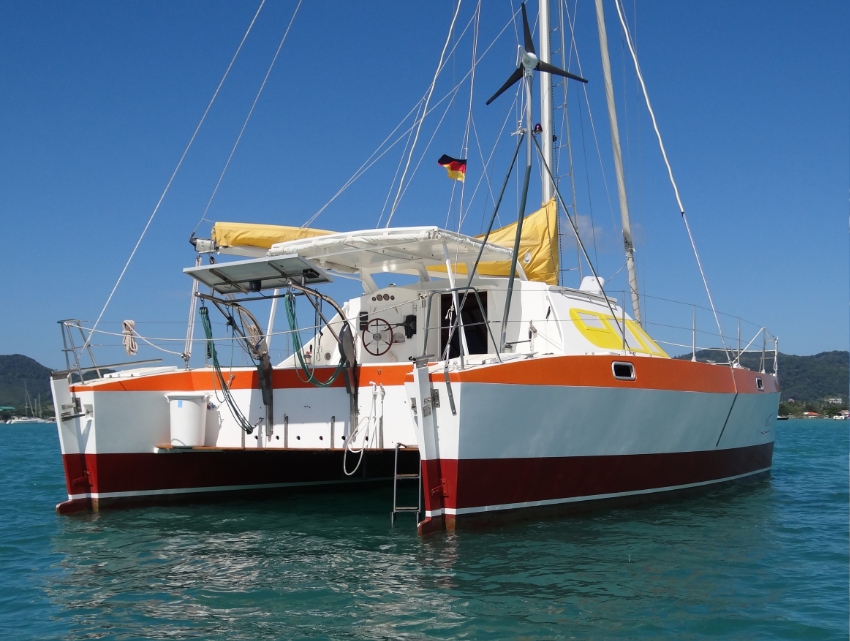

The helm chairs have flip bolsters, fixed armrests, and slide plates to adjust fore and aft. We test lots of things – sometimes by brute force. It also doubles as the fixed base for the helm chairs. The livewell behind the helm seats holds 42 gallons (159 L). The self-draining cockpit has scuppers through solid glass, showing the thickness of the transom. An aft livewell with seating is optional to replace the cooler seats. The 96-quart (90.84 L) Nice coolers serve double duty as seats with the addition of cushions and bolsters. The deck behind the center console measures 8’5” W x 7’8” L (2.56 m x 2.33 m). Storage lockers in the deck behind the fuel tanks are an option. Note the outlines in the aft deck where the sun hits - this is where the fuel tanks are installed. A bow roller and anchor windlass are options. The foredeck (4’ L x 7’3” W – 1.2 m x 2.2 m) is raised and has a tension-hinged hatch over the anchor locker in the center. There are storage lockers over each sponsor. Steve inspects the slope in the deck toward the bow.

Steve likes the stainless-steel rubrail on the Horizon 3000.Ĭapt. The freeboard forward is 52” (132 cm), measured from the water to the top of the caprail.Ĭapt. However, Eastward has chosen to use it throughout the boat, which makes the boat very strong. Limber holes are added to the bottom of each bulkhead and sleeved with 1" (2.5 cm) PVC to ensure that no water can be trapped in the hull.Ĭoosa foam core is very strong and typically used only in high load areas, such as transoms, due to expense. All of the bulkheads are constructed out of 1.5" (3.8 cm) high-density Coosa foam core.

The 3” (7.6 cm) PVC pipes are for rigging. Here we can see the mold with stepped hulls and rounded tunnel as it is prepped to make a new boat. The rights to build from the Kevlacat design were purchased. The proven Kevlacat hull design, seen here with a pilothouse, is popular with fishermen, divers, and search and rescue outfits. It is a proven hull design with a long history of providing a smooth dry ride and the strength to withstand the punishment of extreme conditions. This also eliminates stress cracks in the tunnel. The tunnel is also rounded for superior strength and softer landings, when compared to catamarans that have squared off tunnels. The hull design incorporates a high bow that can cruise at displacement speed into a steep head sea, something that most cats don’t do very well. Today we are evaluating the center console version. The boat comes in four versions: center console, two pilothouse options, and a cuddy cabin - add “Lego” options to suit. He then left BoatTEST and started Eastward Boats and has been happily building customized versions on this hull design ever since.Įast brought a very basic boat to our inspection to demonstrate what he called his “Lego” approach, which is adding components to a clean canvas, bounded only by imagination and a checkbook.
EASTWARD CATAMARAN FOR SALE FULL
For purposes of full disclosure, Dave East worked as a Test Captain for for four years before acquiring the molds for this boat from Kevlacat, an Australian company known for building search and rescue boats. The shear of the boat has higher freeboard forward (52” - 132 cm) than aft (42” - 106 cm).ĭave East and his company, Eastward Boats, build power cats in Fort Pierce, FL. The Eastward Horizon 3000 is a versatile power cat utility boat that can be customized for fishing, diving, search and rescue, or outfitted with accommodations and A/C for overnighting. The Horizon 3000 is rated for and could handle twin 300-hp outboards. Twin 250-hp Evinrude E-TEC G2s on Armstrong brackets provide power and 50.6 mph speed on our test boat. The high bow profile of the Horizon 3000 and the rounded tunnel design make this cat capable of handling head seas with aplomb, something not usual in power cats.


 0 kommentar(er)
0 kommentar(er)
